When was the last time you reviewed your customer service processes?
Let me guess – when you first set up your support team… 5-6 years ago?
Well, a lot has changed since then, so it's time for an update!
To help keep you up to date, we surveyed more than 60 customer service managers to get their take on the latest upcoming customer service trends – and the results might surprise you. 😲
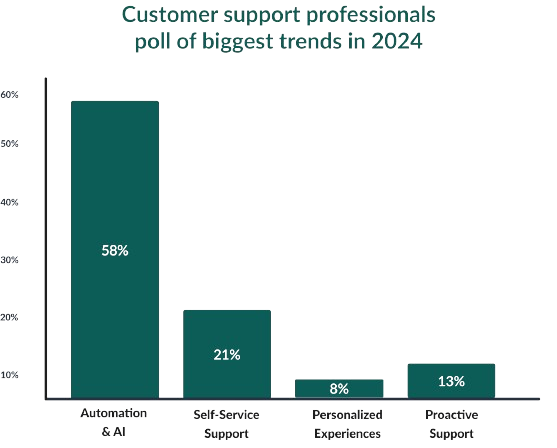
Leading the way is AI and automation, where 58% of customer service managers expect it to be the big customer service trend in 2024, followed by self-service support, personalized experiences, and proactive support.
In addition to the survey, we’ve also identified an ongoing trend with our customers, such as omnichannel support that you also need to consider as part of your customer service approach in 2024.
Customer service trends come and go. Why should I keep up with them?
Let the numbers answer that.
89% of companies say that excellent customer service plays a huge role in the retention of their customers. That’s why it’s important to stay on top of these trends and ensure you’re keeping your customers happy.
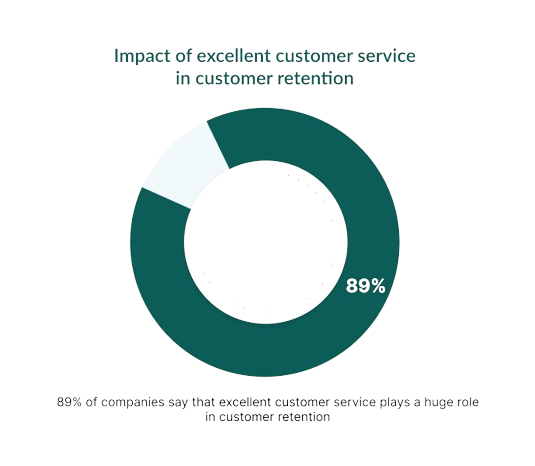
Meanwhile, 84% of companies that are already working to improve their customer service approach are seeing an increase in revenue as a result.

So it’s clear that keeping up with the latest customer service trends ensures a clear path to scalable, sustainable, long-term business growth, as well happy and loyal customers.
5 customer service trends for 2024
Let’s look at the five customer service trends for 2024, and analyze why each trend is important and how your business can benefit from it.
1. Automation & AI
Automation & AI are often grouped together as a category, but they perform similar yet ultimately different roles when it comes to customer service.
Using automation in customer service allows you to set up repeatable tasks or processes to be taken care of automatically.
This could include automating things like email replies, notifications, or even entire workflows – basically, any manual or repetitive customer service task is prime for automation.
Artificial Intelligence (AI) is a catch-all term to describe the use of computer software to perform tasks that would usually require human intelligence to complete.
Examples of AI usage in customer service include things like sentiment analysis of support tickets, translation of foreign language communications, or performing a triage process that covers the initial review, prioritization, and assignment of support tickets.
The big upshot of adding a layer of automation or artificial intelligence to your customer service processes is the time it’ll save your team, freeing them up to focus on adding value by serving your customers in a more customer-centric way.
🤔 Why is AI & automation an important trend?
There’s more competition than ever in almost every business sector.
It means that you can no longer compete on features or pricing alone, you need to do more to differentiate yourself.
One key way to achieve this is to deliver exceptional experiences for your customers. And using AI & automation could be your secret weapon in doing so.
We ran sentiment analysis on social media comments that discussed customers’ experiences of AI & automation in customer support.

79% of comments were either negative or neutral towards the use of automation and AI in customer support. This means only 21% of companies have so far worked out how to use this groundbreaking technology to deliver incredible experiences.
This means that it will take some careful planning and effort to join those 21% who got it right with AI & automation when it comes to offering great customer service.
Not only can AI & automation help you deliver “best in class” experiences for your customers, but it can also help reduce costs by a staggering 30% and increase profitability by a whopping 38%. costs and increase profitability.
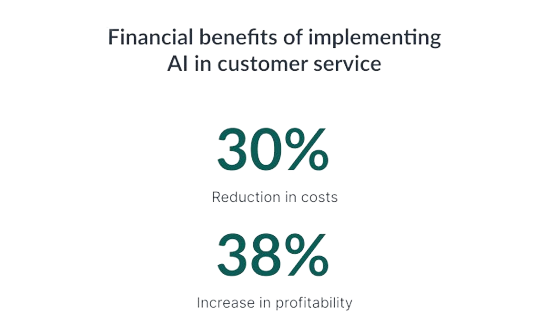
The trick here is to not compromise on quality of customer service, while you’re enjoying the profitability perks. You still need to put effort in keeping your customers satisfied.
💡 How can you take advantage of the AI & automation trend?
Automation and AI are best used as a feature within your existing software, rather than going to the effort and expense of trying to configure your own AI and automated workflows using external 3rd party tools.
So, in order for you to leverage both automation and AI within your customer service offering, you need a customer service tool that has AI functionality baked in and ready to go.

A dedicated customer service platform, like SuperOffice Service, gives you all the tools you need to deliver exceptional support: helpdesk, CRM, live chat, and a knowledge base, including AI & automation built in to help you supercharge your efforts from day one.
2. Self-service support
Self-service support is the process of establishing and maintaining support channels that your customers can use independently in order to resolve issues or answer questions they have about your product.
You’re probably already familiar with some of the main self-service support channels currently available, such as knowledge bases or chatbots.
One of the key benefits of establishing self-service support channels is that it enables your customers to help themselves quickly and efficiently at any time of the day or night – enhancing their overall experience with your brand as a result.
🤔 Why is self-service support an important trend?
Self-service support isn’t new in itself, but including it as part of your mix of customer service channels is becoming increasingly popular.

One reason for this is that customers are demanding self-service support options now more than ever. In fact, an astonishing 88% of customers expect to be able to use self-service support options when they interact with a business.
As well as the expectations of customers, establishing self-service support channels in your business also comes down to a question of customer preferences.
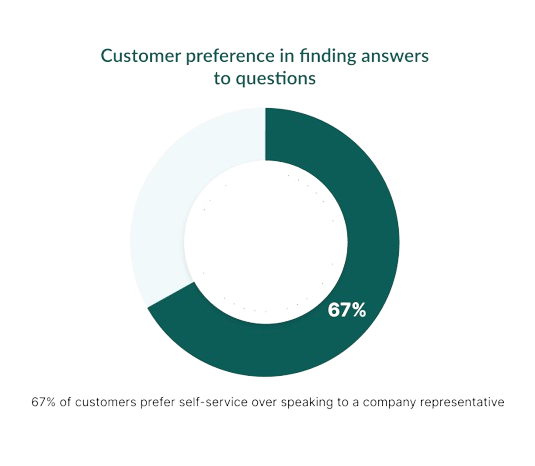
As much as 67% of your customer base would actually prefer to use a self-service support option rather than speak to a support agent or customer service representative. Often the reason behind this is convenience and the speed of resolution vs. the perceived time it would take to submit a support ticket or phone the support helpline.
Self-service support isn’t just an important trend when it comes to satisfying your customers. It also offers businesses the opportunity to make their support services more scalable, meaning you are available for customers 24/7 without the need for additional staff or significant costs.
💡 How can you take advantage of the self-service support trend?
If you’re not already including self-service support as part of your customer service mix, then there are two ways to get started.
Step 1: evaluate if your product or service can truly benefit from self-service options. The simplest way to do this is to review previous support tickets or call logs to understand which questions keep popping up time and time again.
It’s these recurring questions that are prime for inclusion in a self-service support tool such as a knowledge base.
Step 2: make sure you have the right systems in place to provide self-service options as part of your customer service offering.

Choosing customer service software, like SuperOffice Service, means you’ll have everything you need to deliver exceptional customer service: including helpdesk, CRM, live chat, customer engagement platform, and the knowledge base. All tools to offer self-service support to your customers.
3. Proactive support
Customer support and service are reactive by nature.
Your support agents wait to receive inbound calls, tickets, or messages and then go on to deal with the issues that are raised by your customers.
But what if there was a different (better) way?
Introducing proactive support!
Proactive support is all about getting ahead of any potential issue or problem and contacting the customer first.
- If you operate a B2B SaaS company, this might include alerting your customers to any unexpected system downtime before your customers contact you to complain.
- If you’re in B2B eCommerce, you might want to let your customers know that their shipment will be late than previously agreed due to unforeseen circumstances.
- If you work in business banking and your systems spot fraudulent activity on your customers’ accounts, you may wish to contact them directly to verify these transactions.
The benefit of being proactive means you can not only get ahead of issues, but you can also use customer service data to understand your customers’ needs even better than they do – with a view to maintain and extend your commercial relationship with them.
🤔 Why is proactive support an important trend?
Customer service is all about keeping a positive relationship with your customers by providing them with the help and support they need during the time they’re doing business with your company.
Proactive support offers you the opportunity to supercharge your customer service processes and boost both retention and satisfaction rates – aka to delight your customers.
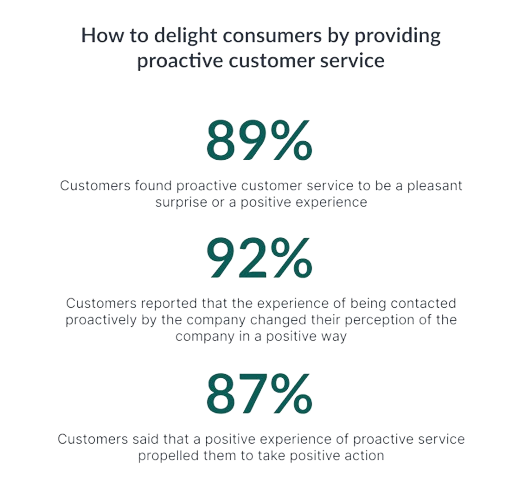
This is because research shows that customers love proactive support:
- 87% of customers believe that a positive experience with proactive support propelled them to take positive action.
- 89% of customers found that proactive support was both a pleasant surprise and a positive experience all around.
- 92% of customers reported being contacted proactively by a company, and it positively changed their perception of that company.
💡 How can you take advantage of the proactive support trend?
Proactive support isn’t just a software feature you can activate to solve all your issues. It involves a wholesale approach to your customer service strategy.
To get a better idea of when you should be using proactive support vs. more traditional reactive support, ask yourself these questions:
- Will our customers appreciate proactive support?
- What kinds of issues should we flag with them proactively?
- What are our internal metrics around proactive outreach?
- How are we going to track the effectiveness of our proactive approach?
Once you’re clearer on how proactive support could work for your organization, you then need to make sure your support agents have access to your customer service data, using a dedicated customer service platform like SuperOffice Service.
4. Personalized experiences
Every customer wants to feel valued.
One way to demonstrate just how much your customers mean to you is to include personalized experiences as part of your customer service offering.
But personalization is more than just using their name. So, what does personalization really mean?
Put simply, creating a personalized service experience for your customers could include things like:
- Only communicating with them using their preferred channels, so they feel listened to and respected.
- Using their customer service data in order to help quickly solve their specific issues.
- Share personalized content with them that is specific to their current point in the journey with your product or service.
Essentially, it’s using any information, data, or preference the customer has shared with you to your advantage in order to improve the service you offer and make it more tailored to their specific needs.
🤔 Why are personalized experiences an important trend?
There are two key reasons why you should consider adopting a personalized experience approach to customer service (if you haven’t already).
First up, it’s all about customer satisfaction.

Research from McKinsey indicates that not only do an incredible 71% of customers expect to have personalized interactions with a company, but also a mind-blowing 76% of customers actually get frustrated if they don’t receive them.
This all means – if you wail to offer personalized experiences, you risk to alienate a lot of customers, thus jeopardizing your retention rates and overall profitability.
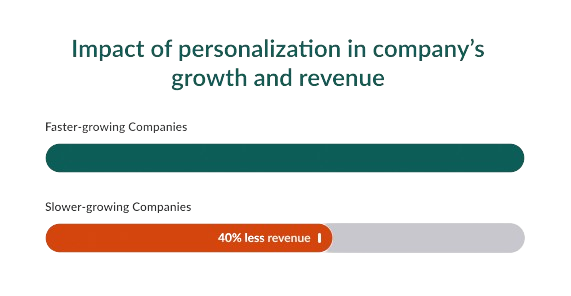
The same research from McKinsey found that companies that failed to adopt personalized experiences grew slower (realizing 40% less revenue) than those that did.
💡 How can you take advantage of the personalized experiences trend?
Again, the right software can help you create personalized experiences for your customers.
By having all your customer service data centralized in one tool, like SuperOffice Service, you’ll be able:
- to understand each of your customers’ needs, at any point in their journey with you;
- to create personalized workflows to enhance the experience for your customers even further.
Using dedicated customer service tools will give you everything you need to create personalized experiences that will boost your customer satisfaction and retention rates and help achieve growth and profitability, too.
5. Omnichannel support
You may have already heard of multichannel support, which offers customers a number of different ways or ‘channels’ to access customer service and support.
Multichannel is a great step in the right direction when it comes to improving your customer service offering. But omnichannel takes things one step further to dramatically improve the overall service experience for your customers.
This is because omnichannel not only allows customers to use any of the channels made available as part of a multichannel support approach, but it also unifies everything for a single, cohesive experience.
Here is an illustration of the omnichannel approach: if a customer starts their interaction with your support team using one channel (e.g., live chat) and then switches to another channel (e.g., the helpdesk or phone support) then all the information shared and context provided is made available centrally.
This creates a seamless experience for your customers and removes the need for customers to repeat themselves – the thing which frustrates 77% of customers.
Switching to omnichannel moves your customer support offering right into the “excellent” category, thus increasing your customer satisfaction scores.
🤔 Why is omnichannel support an important trend?
Delivering high-quality customer service is one of the most important factors for ongoing business success.
One of the best ways to mitigate against the threat of churn is to introduce an omnichannel customer service strategy.
In fact, businesses that adopt omnichannel support experience 91% greater year-on-year retention rates compared to their previous approach to customer service.

On top of this, research shows that companies that adopt an omnichannel customer engagement strategy will, on average, retain 89% of their customers, compared to a dangerously low 33% customer retention rate for businesses that don’t embrace omnichannel.
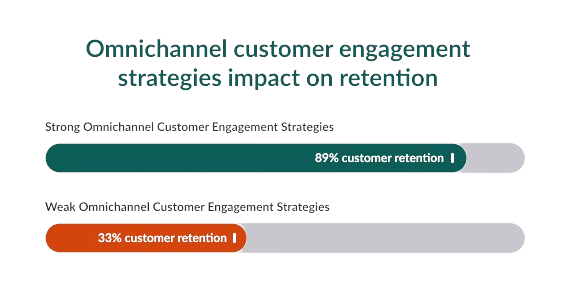
This all goes to show that you should make omnichannel support one of your top priorities for 2024.
💡 How can you take advantage of the omnichannel support trend?
One of the best (and easiest) ways to embrace omnichannel support in your business is to consider a dedicated software that provides you with everything you need out of the box.

Using an all-in-one platform, like SuperOffice Service, gives you a suite of best-in-class tools like helpdesk, CRM, live chat, and the knowledge base - helping you to offer your customers a seamless omnichannel support experience without any complex integrations or technical issues.
Leave the technology to ensure the omnichannel experience for your customers. And dedicate more time to providing “best in class” support during every customer interaction.
Software to keep up with customer service trends
What if you could take advantage of these latest customer service trends with an all-in-one easy-to-use platform that includes everything you need to better serve your customers - like AI & automation, CRM, help desk, live chat, and knowledgebase?
You can stay up to date with customer service trends by using a platform like SuperOffice that offers:
- Automation & AI – take care of repetitive tasks enabling your team to add value
- Self-service support – use knowledge base and chat to help your customers 24/7
- Proactive support – monitor customer data and reach out whenever relevant
- Personalized experiences – collect and use customer data for a tailored service
- Omnichannel support – offer a fully-integrated, seamless experience for your customers
Conclusion
As a business, it’s critical for you to put your customers at the heart of your operations if you want to achieve sustainable, long-term growth.
89% of companies currently see customer service as critical to maintaining high rates of customer retention, while 84% of companies who are working to improve their customer service offering are seeing increases in revenue as a result.
So, it’s clear that customer experience matters now more than ever.
You can’t leave customer service to chance or simply do what you’ve always done and hope for the best.
As technology evolves and your customers' needs become more sophisticated, you’ll need to keep on top of the latest customer service trends in order to meet the demands of your customers.



